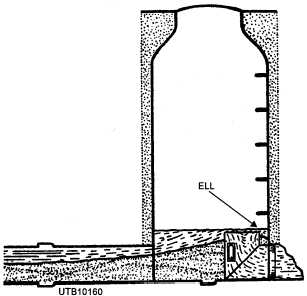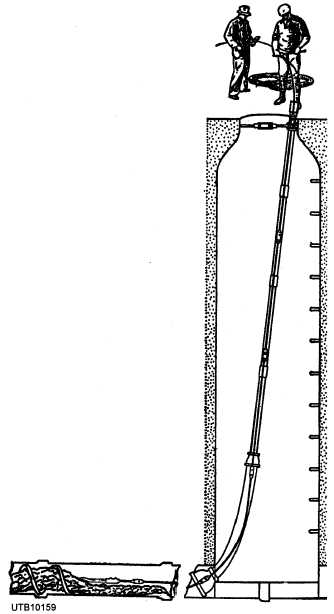
Figure 5-51. - Sand trap.

Figure 5-50. - Root removal by steel rod and auger, manual operation.
fit the sewer pipe, may be used, as shown in figure 5- 51, to collect the sand. Commercial traps are available with adjustable slots to lower the water level below the top of the trap. Sand is removed by scoops or buckets.
For heavy sand deposits, a cable-drawn bucket is used, especially for storm sewers and larger sanitary sewers. The cable may be pulled by a hand winch, by a power winch, or by a truck with the cable through an anchored sheave. The sewer can be damaged if the bucket catches on misaligned joints, improper house connections, or other fixed obstructions, especially with power-driven buckets.
Turbine-driven tools (fig. 5-52) clean sewers with difficult obstructions and grease coatings. These tools are powered by water under pressure from a fire hose. The tool and hose are pulled through the sewer by a cable.
Various types of power-driven sewer-cleaning machines are available. These machines normally have a 3/4-horsepower electrically reversible motor and weigh about 90 pounds. They are especially designed for clearing sewer pipelines, ranging from 1 l/2 inches to 10 inches in diameter and up to 200 feet in length. Some have a cable counter indicator, so the operator knows the distance the tool is in the line. Others have a headlight to aid you in working the dark areas.
A major difficulty with sewer systems buried in the ground is tree ROOTS. These are hard to detect just by looking in the manholes. With trees growing rather close to a sewer line, you can expect roots to cause a break in the line. Such trees as poplars, willows, and elms are the most troublesome when it comes to root growth. When these trees are growing within 100 feet of a line, you can look for trouble from roots sooner or later. Take a close look at figure 5-53 which shows tree roots penetrating a line.
One method for removing roots in a sewer is to apply copper sulfate (blue vitriol). Another method is to use cable drawn scrappers; these may be homemade or equipment as shown in figure 5-50. Try copper sulfate first since this is the most economical.
When a sewer is completely stopped up, it is useless to apply copper sulfate. A partially blocked line that is flowing from 5 to 10 gallons per minute only
Continue Reading